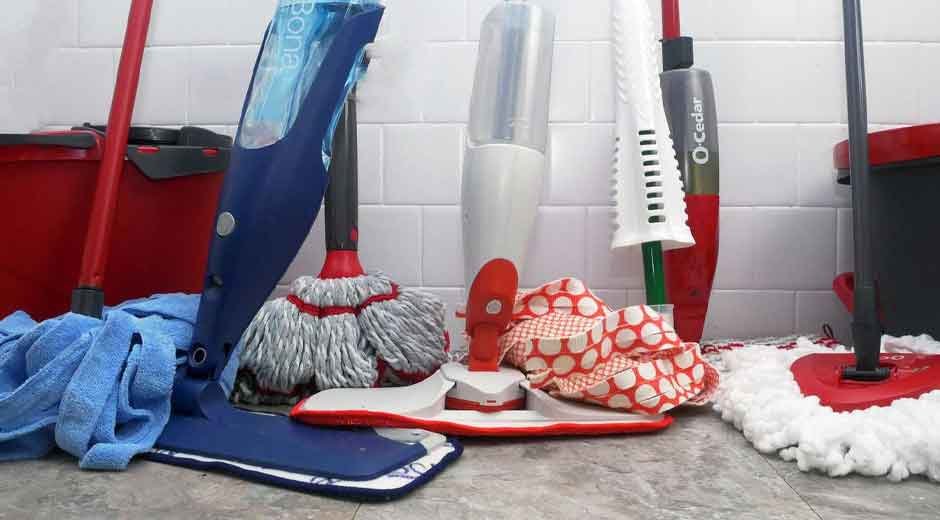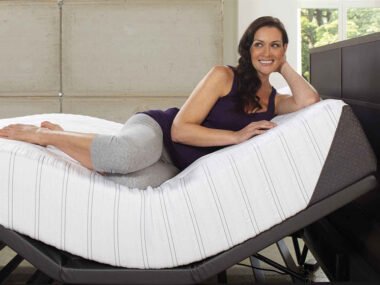The right mop can significantly improve how clean and fast you get your floors. While sponge mops have been a home go-to for decades, microfiber mops are quickly gaining popularity for their superior dirt-trapping ability and eco-friendliness.
But which one cleans better?
Studies show that microfiber mops can remove up to 99% of bacteria using only water, compared to around 30% with traditional mops. They’re also lightweight and washable and require less cleaning solution. On the other hand, sponge mops are great for soaking up spills and scrubbing sticky messes, making them useful in high-traffic areas or for deep-cleaning jobs.
This guide will compare microfiber and sponge mops across key factors such as cleaning performance, absorbency, ease of use, durability, maintenance, cost, and environmental impact.
What is a Microfiber Mop?
A microfiber mop consists of a head made from fine synthetic fibers, typically polyester and polyamide. These tiny fibers are split during manufacturing, creating a broader surface area that can trap dirt, dust, and bacteria more efficiently than traditional mops. Microfiber mops are available in various designs, such as flat mops, looped-end mops, and spray mops.
What is a Sponge Mop?
A sponge mop features an absorbent sponge head made from cellulose or synthetic materials. The sponge is typically mounted on a flat surface with an attached handle and often has a built-in wringer mechanism. Sponge mops are known for their high absorbency and are commonly used for soaking up spills and cleaning tile or linoleum floors.
Various factors, such as cleaning efficiency, durability, and hygiene, must be considered when deciding between microfiber and sponge mops. Choosing the right mop for the job ensures the best results, whether you’re tackling spills, dust, or heavy-duty grime. It’s about finding a mop that fits your floor type and cleaning needs.
Microfiber vs. Sponge Mops: The Core Differences
Considering aspects like cleaning effectiveness, floor type compatibility, durability, and upkeep is crucial when deciding between microfiber and sponge mops. Here’s a complete comparison to help you pick which mop best meets your needs.
Material and Mechanism
- Sponge Mops:These mops use a highly absorbent synthetic sponge head, typically made from cellulose. The mop relies on soaking liquids and trapping dirt in its porous structure. It has a wringing mechanism to remove excess water, which helps with cleaning.
- Microfiber Mops:Made from synthetic fibers finer than a human hair, microfiber mops have a unique structure that uses electrostatic attraction to pick up dust and dirt. The fine fibers also provide scrubbing power and absorb liquids through capillary action.
The primary difference between microfiber and sponge mops is in the materials and how they clean.
This fundamental difference in material and cleaning mechanism dictates the strengths and weaknesses of each type of mop.
Absorbency
- Sponge Mops:Known for soaking up large amounts of liquid, but they can drip if not wrung out properly.
- Microfiber Mops:Also highly absorbent, but they release water more evenly, making them ideal for delicate floors like hardwood, where excess water can cause damage. Microfiber mops are better at controlling moisture release.
The Verdict: While both are absorbent, microfiber often offers a better balance of high absorbency with controlled release, making it more versatile for various floor types.
Cleaning Effectiveness
- Sponge Mops:They can pick up surface dirt but may not trap smaller particles as effectively. They may require multiple passes to clean thoroughly.
- Microfiber Mops:These mops capture large debris and tiny particles like dust, bacteria, and allergens. Microfiber’s electrostatic charge and scrubbing power make it more effective at lifting dirt, often with fewer passes.
The Verdict: Microfiber mops generally offer superior cleaning effectiveness, particularly when capturing fine particles and microbes, leading to a deeper & more hygienic clean.
Durability
- Sponge Mops:Sponge heads wear out over time and can become brittle or tear. They need to be replaced frequently, increasing long-term costs.
- Microfiber Mops:These are more durable and last longer. Microfiber pads can withstand many washes without losing effectiveness, making them a more sustainable investment.
The Verdict: Microfiber mops generally offer superior durability and a longer lifespan than sponge mops, making them a more sustainable investment in the long run.
Maintenance
- Sponge Mops:Cleaning a sponge mop can be challenging, as dirt can be trapped in the sponge. It may require soaking and special cleaning solutions to keep it sanitary.
- Microfiber Mops:Microfiber mop heads are easily cleaned and often machine washable. They dry quickly and require minimal maintenance, contributing to better hygiene.
The Verdict: Microfiber mops are significantly easier to clean and maintain than sponge mops, contributing to better hygiene and a longer lifespan of the mop head.
Environmental Impact
- Sponge Mops:The production of sponge mops can have a higher environmental impact, and frequent disposal of worn-out sponges adds to waste.
- Microfiber Mops:Microfiber mops are more environmentally friendly and require less water and cleaning solution. Their long lifespan also means fewer replacements, reducing overall waste.
The Verdict: Microfiber mops generally have a lower environmental impact due to their reduced water and chemical usage, longer lifespan, and potential for being made from recycled materials.
Cost-Effectiveness
- Sponge Mops:They are cheaper upfront but require frequent replacement of sponge heads, which can add up over time.
- Microfiber Mops:Microfiber mops are more expensive initially, but last longer and save on cleaning solutions and water. Their durability makes them more cost-effective in the long run.
The Verdict: In the long term, microfiber mops are frequently more cost-effective because of their durability, lower water use, and lower need for cleaning supplies, even though their initial cost may be more significant.
Tailoring to Your Needs
The “better” mop ultimately depends on your individual cleaning requirements, the kinds of flooring in your house, and your own tastes.
Choose a Sponge Mop If
- Your primary need is to soak up large spills quickly.
- You are on a very tight budget for the initial purchase.
- You are primarily cleaning smooth, non-delicate surfaces.
- You don’t mind the potential for less effective fine particle removal.
Choose a Microfiber Mop If
- You prioritize superior cleaning effectiveness, especially for fine dust, allergens, and bacteria.
- You have delicate flooring like hardwood or laminate that requires controlled moisture.
- You value durability and a longer lifespan of the mop head.
- You prefer easy machine washing and quick drying of the mop head.
- You are looking for a more environmentally friendly cleaning option.
- You want a more cost-effective solution in the long run.
In many cases, a high-quality microfiber mop system offers a more versatile and effective cleaning solution for a broader range of needs. Its superior cleaning power, gentler action on delicate floors, ease of maintenance, and long-term cost-effectiveness make it a compelling choice for modern households.
The Takeaway
While microfiber mops excel in efficiency, hygiene, and long-term value, making them ideal for home and commercial use, sponge mops offer a more affordable option for spill cleanup on tiled floors or tasks requiring disposable heads. The ideal option depends on your preferences, financial situation, and cleaning requirements. A better mop results in a healthier home and cleaner floors.
References:
https://thecleaningstation.com/blog/different-types-of-mops-explained-which-is-best/?srsltid=AfmBOopGGEMioohJGe2oqHu_t1_gpsbLiQcapozxoGkrg3hXiwvYKsKp
https://www.cnpowerclean.com/news/microfiber-mops-vs-cotton-string-mops-which-one-is-better.html
https://www.bona.com/en-us/homeowner/how-to/why-are-microfiber-mops-better-for-cleaning/
https://www.hillyard.com/blog-231003-string-mops-flat-mops-which-is-better
https://www.thespruce.com/regular-mop-vs-microfiber-mop-11732128
https://usa.ungerglobal.com/blog/cotton-string-mops-vs-microfiber-string-mops-8-considerations-for-commercial-floor-cleaning/
https://www.microfiberwholesale.com/blogs/blog/right-mops-techniques-any-floor










